Introduction
- Organizational culture in nursing is crucial.
- Results in job satisfaction, reduced turnover.
- Positively or negatively influences nursing practices.
- Organizational values tend to influence behavior (Bridges, 2018).
- Establish acceptable principles that govern operations.
- Programs instill organizational culture and values.
Organizational culture in nursing and health care sector is crucial. It results in enhanced job satisfaction, reduced turnover, quality of care, and patient outcomes. Although organizational culture is not always talked about in the health care industry, it plays a vital role in positively or negatively influencing nursing practices. Organizational values have a tendency of influencing the behavior of the people and the decisions they make (Bridges, 2018). They also establish the acceptable principles that govern operations within the organization. Nurse leaders should create programs to effectively instill organizational culture and values for enhanced success.
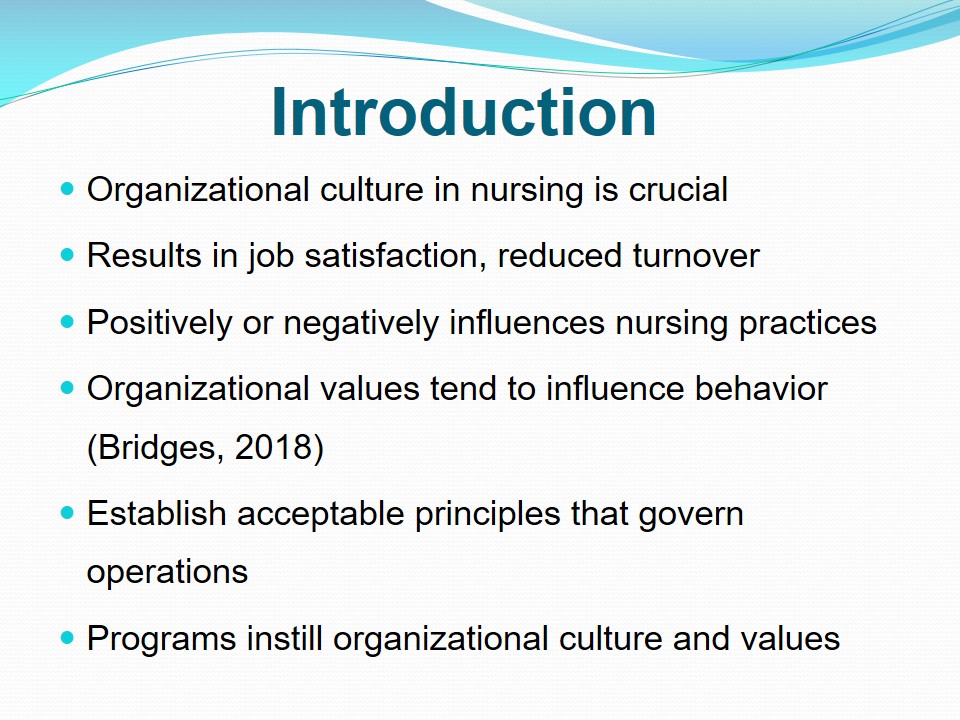
Alignment
- Improved nursing care and patient outcomes.
- Regularly improved to uphold the quality.
- Operations inclined to personal value systems.
- Not in best interest of patients (Bridges, 2018).
- Pull organizational values in different directions.
- Diminishing focus and energy towards attainment.
Alignment between the values of an organization and those of nurses results in improved nursing care and positive patient outcomes. Nurses’ insights of organizational values should be regularly improved as a way of upholding the quality of care. Devoid of a successful alignment, nurses may pursue operations that are more inclined to their personal value systems. This could result in behaviors and practices that are not in the best interest of patients or the organization (Bridges, 2018). Moreover, lack of an effective alignment could lead to the pulling of organizational values in different directions hence diminishing focus and energy towards attainment of the set goal in nursing care.

Overcome Workplace Challenges
- Sentiments of being underutilized by management.
- Work overload, conflicts, and job dissatisfaction.
- Addressing underlying challenges is not easy (Gluyas, 2015).
- Effective communication techniques overcome workplace challenges.
- Promote culture of trust and precision.
- Overcome barriers of realizing the objectives.
Some common organizational challenges encompass sentiments of being underutilized by the management, work overload, conflicts with co-workers, and job dissatisfaction. The use of effective communication techniques to address the underlying challenges is not always easy and an individual should be careful concerning the advice to give (Gluyas, 2015). An individual, for example, nurse leader, can use effective communication techniques to triumph over workplace challenges. This could occur through communicating effectively to all nurses in a bid to promote a culture of trust and precision. It encourages nurses and other stakeholders to feel that they can easily overcome the barriers existing in the way of realizing their objectives.
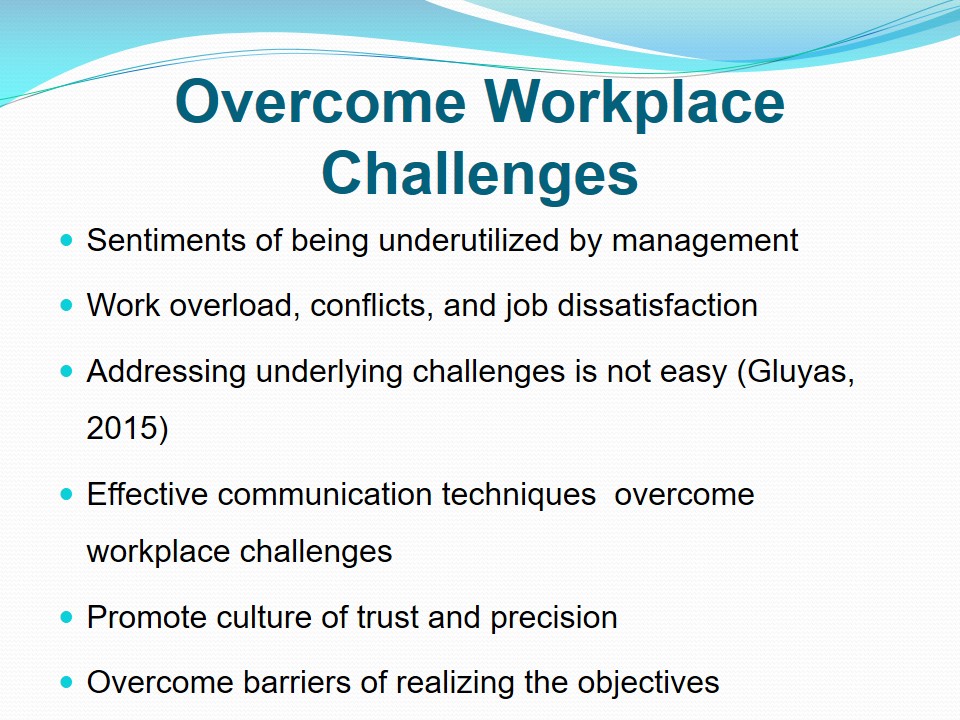
Encourage Collaboration
- May encourage teamwork among staff members.
- Facilitates continuity and intelligibility in nursing.
- Effective communication techniques to overcome misunderstandings.
- Which result in high performing teams (Gluyas, 2015).
- Care and support cannot be underrated.
- Group effort plays a vital role.
The application of effective communication approaches may encourage teamwork among staff members. Enhanced collaboration facilitates continuity and intelligibility in nursing care teams. An individual can foster collaboration by making use of effective communication techniques to overcome misunderstandings and interaction problems. These are the commonest bases of workplace discord and interpersonal issues. Effective communication creates loyalty and confidence, which result in high performing teams (Gluyas, 2015). Although suitable boundaries and practices are vital, a show of care and support cannot be underrated. At its best, the use of effective communication helps to foster group effort that plays a vital role in the prevention of possible errors.
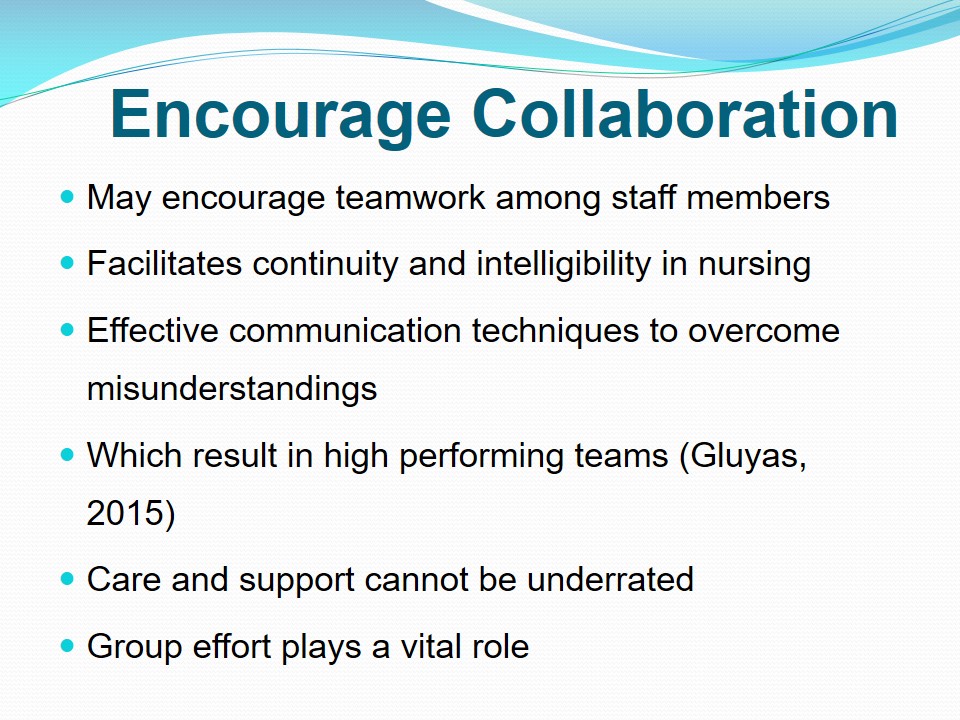
Promote Problem Solving
- Means of navigating an argument successfully.
- Maintaining concentration on a given issue.
- Petty actions lead to devastating reactions (Gluyas, 2015).
- Unaddressed conflicts can destroy workplace relationships.
- Difficult to tackle the existing problems.
- Contribute to the achievement of goals.
An individual can use effective communication techniques to support problem solving by first understanding the best means of navigating an argument successfully. This entails maintaining concentration on a given issue and evading personal attacks. Conflicts may spark from petty actions or words and lead to devastating reactions and behaviors (Gluyas, 2015). Unsolved or poorly addressed conflicts can destroy workplace relationships. This makes it difficult to tackle the existing problems. Through effective communication, problems in an organization can be solved successfully and lead to stronger, deeper affiliations hence contributing greatly to the achievement of the set goals.
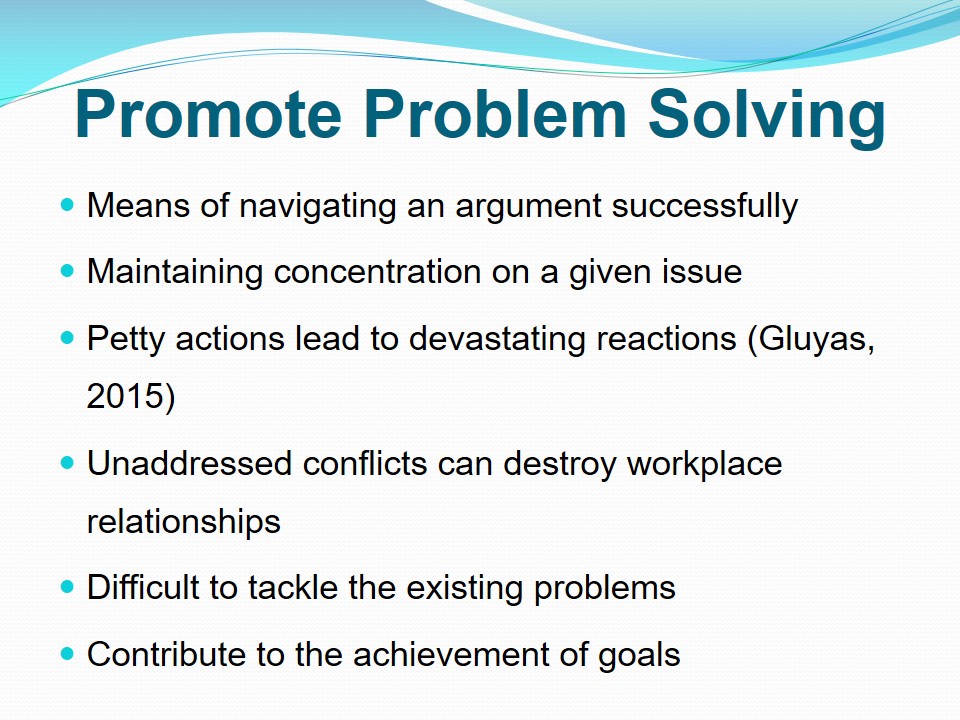
System Needs and the Culture of Health
- Coordinated and intensive set of approaches.
- Encompass plans, strategies, and connections intended.
- Uphold the fitness of the workforce (Sellers et al., 2015).
- Decreases direct expenditures such as premiums.
- Reduced absenteeism and increased worker productivity.
- Create environments where safety is guaranteed.
System needs and the culture of health might influence the outcomes by establishing a coordinated and intensive set of approaches. They encompass plans, strategies, and connections intended to meet the medical and safety demands of the population. Safety needs and the culture of health uphold the fitness of the workforce (Sellers et al., 2015). This decreases direct expenditures such as insurance premiums and reparation demands. It also positively influences numerous costs in terms of reduced absenteeism and increased productivity of the workers. Organizations should strive to establish a wellness culture which is worker-centered and create favorable environments where safety is guaranteed.
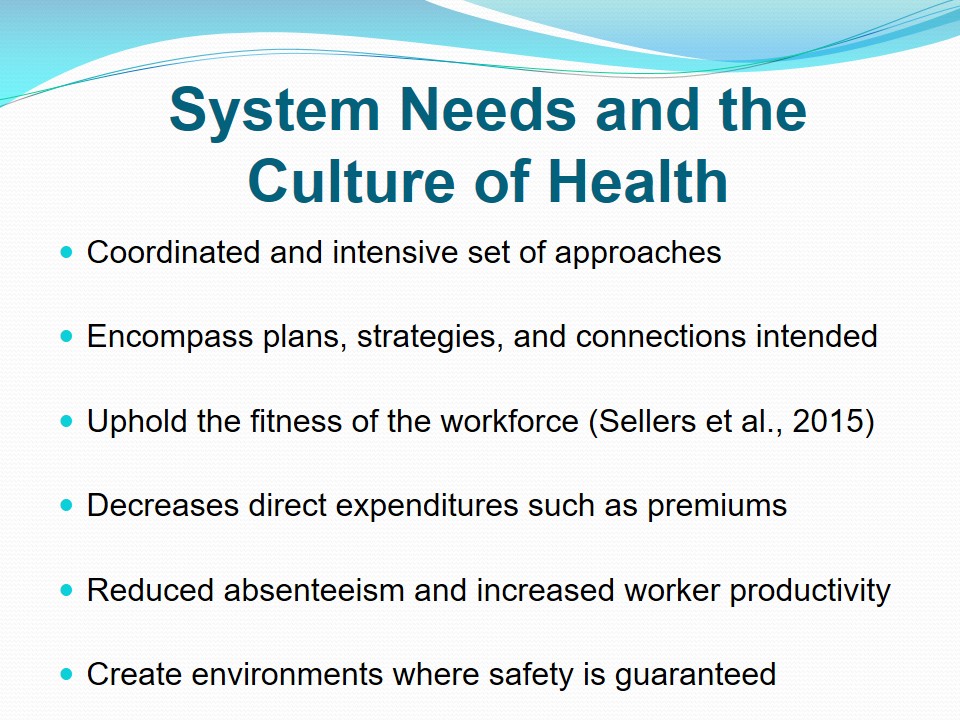
Health Promotion and Disease Prevention
- Well-being across demographic and sociocultural segments.
- Enhanced by promotion of healthy societies.
- Judgments that result in healthy lifestyles.
- Have the capacity to promote well-being.
- Avoid risky habits that cause diseases (Sellers et al., 2015).
- Encompass fitness education and preventive screenings.
System needs and the culture of health relate to fitness promotion and disease prevention since they ensure well-being across demographic, geographic, and sociocultural segments. This is enhanced by the promotion of healthy impartial societies. It is guided by private and public decision making where everyone has the chance to make judgments that result in healthy lifestyles. They have the capacity to promote the well-being of people through inculcating healthy behaviors and avoidance of risky habits that can cause diseases (Sellers et al., 2015). Examples of safety needs and culture of health components encompass fitness education lessons, tobacco-free workplace policies, and free preventive screenings to mention a few.
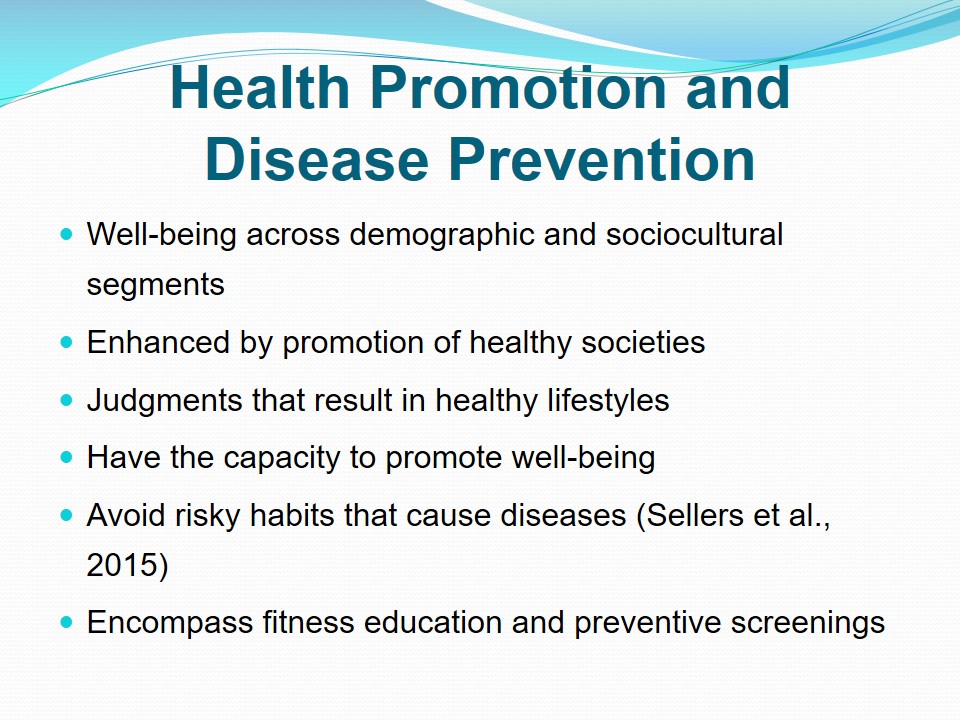
A Specific Instance
- Nurse at a Hospital was negligent.
- Infringement of the standard of care.
- Needed a bilateral knee replacement operation.
- Did not monitor patient’s vital signs.
- Failed to inform the anesthesia unit.
- Stop the administration of epidural analgesia.
A nurse at a General Hospital where I was undertaking my internship was accused of negligence and infringement of the standard of care. The nurses had attended to a patient who was in need of a bilateral knee replacement operation. In her practice, the nurse did not monitor and document the patient’s vital signs and reaction to epidural analgesia. Moreover, she failed to inform the anesthesia unit of alterations in the patient’s rate of sedation or stop the administration of epidural analgesia in line with the nursing policy and organizational values when arousing turned out to be difficult.
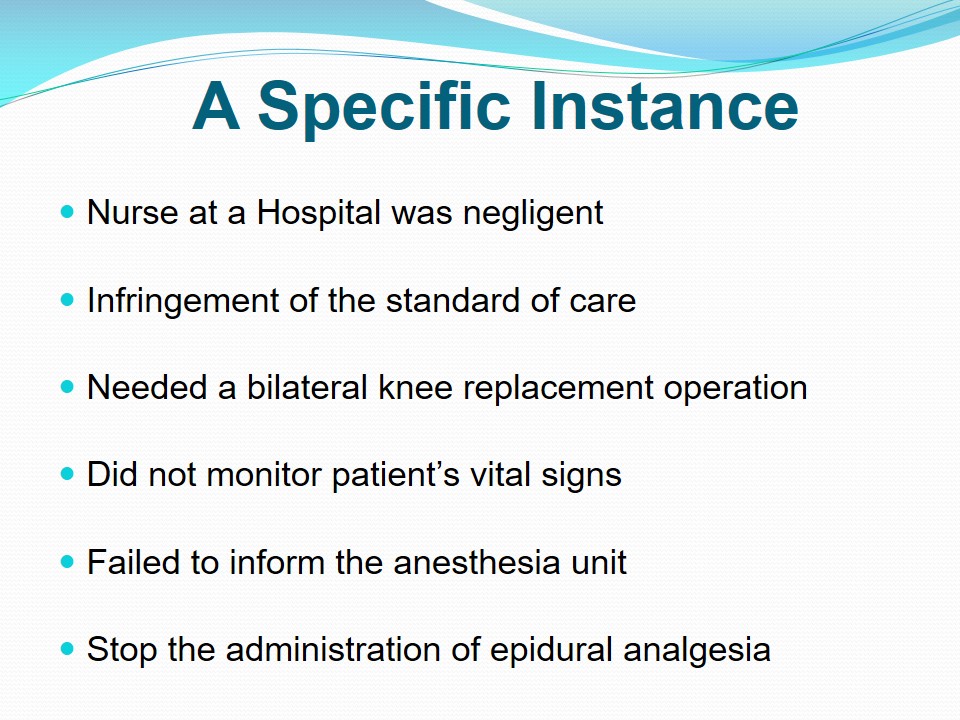
Impact
- After 48 hours, the patient died.
- Family filed charges against the nurse.
- Result in the obstruction of airway (Bridges, 2018).
- Conscientious as per the organizational values.
- Would have identified decreasing pulse rate.
- Focus and attentiveness for improved outcome.
About 48 hours following the bilateral knee replacement surgical procedure, the patient died from respiratory problems and cardiac arrest. His family filed charges against the nurse, attributing the death of the patient to nursing malpractice. Opioids lead to respiratory depression and deepened sedation may result in the obstruction of the airway by the tongue (Bridges, 2018). Had the nurse been conscientious as per the values of the organization, the patient would have survived. Careful monitoring would have identified the patient’s decreasing pulse rate, breathing, and degrees of oxygen saturation. Aligning the values of the organization and the individual nurse would have created greater focus and attentiveness for improved patient outcome.

Conclusion
- Values bring about enhanced job satisfaction.
- Influence performance of workers and choices.
- Quality of care and patient outcomes.
- To overcome challenges in the workplace.
- Sway outcomes by creating harmonized approaches.
- Concentration and care improved patient outcome.
Organizational culture and values in nursing bring about enhanced job satisfaction. They influence the performance of workers and the choices they make. Aligning the values of an organization and those of nurses improves nursing care and causes positive patient outcomes. A nurse leader can employ effective communication methods to subdue challenges in the workplace. System needs and the culture of health sway the outcomes by creating a harmonized and exhaustive set of approaches. Alignment of the values of the organization and the individual nurse ensures greater concentration and care for improved patient outcome.

References
Bridges, E. (2018). Executive ethical decisions initiating organizational culture and values. Journal of Service Theory and Practice, 28(5), 576-608.
Gluyas, H. (2015). Effective communication and teamwork promotes patient safety. Nursing Standard (2014+), 29(49), 50-56.
Sellers, K., Leider, J. P., Harper, E., Castrucci, B. C., Bharthapudi, K., Liss-Levinson, R., … Hunter, E. L. (2015). The public health workforce interests and needs survey: The first national survey of state health agency employees. Journal of Public Health Management and Practice, 21(6), 13-27.